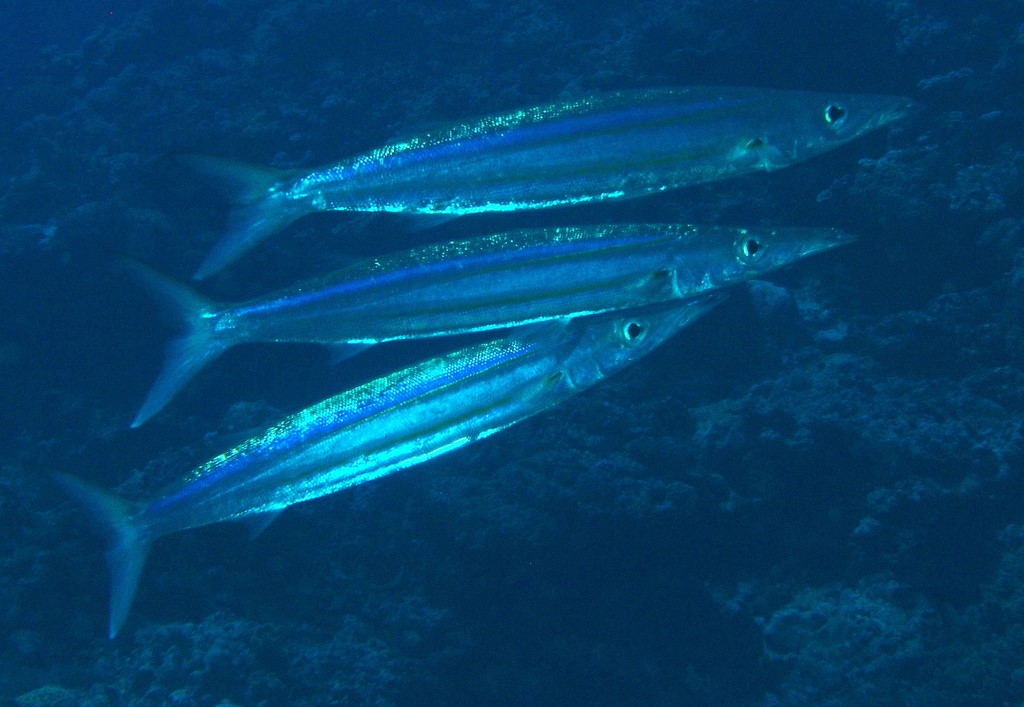SPHYRAENA STELLATA - (MORISHITA & MOTOMURA, 2020)
Actinopterygii (Gigaclass) > Actinopteri (Class) > Teleostei (Subclass) > Carangiformes (Order) > Centropomoidei (Suborder) > Sphyraenidae (Family) > Sphyraena (Genus)
Barracuda à bandes jaunes, Yellow-striped Barracuda, Hoso-kamasu, 細ーカマス,
Description
Dorsal spines (total): 6; Dorsal soft rays (total): 9; Anal spines: 2; Anal soft rays: 10. One gill raker on first gill arch; Pelvic fin insertion located slightly before vertical through first dorsal fin origin; Pored lateral line scales: 134-141 (usually: 137), total lateral line scales: 139-148 (usually: 146); Scales above and below lateral line: 15-17 (usually: 15) and 14-16 (usually: 15), respectively; Snout comparatively short, its length: 13.6-15.8 (usually: 14.4) % SL; Upper jaw short, its posterior tip not reaching to below anterior nostril, its length: 10.0-12.2 (usually: 10.8) % SL; Eye small, orbit diameter and depth: 4.3-7.0 (usually: 4.9) % and 3.9-5.6 (usually: 4.5) % SL, respectively; Anal-fin base shortish, its length: 6.9-8.1 (usually: 7.5) % SL; Last dorsal and anal-fin ray lengths: 4.0-5.6 (usually: 4.7) % and 3.6-5.6 (usually: 4.6) % SL, respectively; Anus not close to anal-fin origin, anterior and posterior margins of anus to anal-fin origin: 7.5-11.9 (usually: 9.9) % and 5.2-8.3 (usually: 6.8) % HL, respectively; Head sensory canal pores on suborbital area simple or poorly branched, their lowermost parts not close to lacrimal bone margin, large smooth area lacking canal pores present on mid-margin of lacrimal bone. Max. length: 60.0 cm TL, common length: 50.0 cm TL. Depth range: 1 - 100 m, usually: 3 - 30 m.
Color
Head and body dorsally yellowish-greenish-silver (blackish), ventrally whitish-silver. Two narrow yellow stripes on lateral body surface; Upper line from upper margin of opercle to center of caudal-fin base, on lateral line scales; Lower line from uppermost point of pectoral fin insertion to lower caudal fin base. Jaws and lips whitish-silver. Pupil black. Pectoral fin darkish transparent, a small black blotch on uppermost point of pectoral-fin base. Spines of first dorsal fin whitish-gray. Spines and rays of second dorsal fin darkish gray; Membrane darkish transparent. Spines and rays of pelvic fin white, membrane whitish translucent (rarely with a small black blotch on pelvic fin insertion). Anal-fin spines whitish; Membrane whitish translucent. Caudal fin gray.
Etymology
Sphyraena: derived from the Greek, sphura = stinger, stake. Aristotle mentions the name of this fish only once (book IX - History of animals - chapter II). The name refers to the "muffle that he made like a stake".
stellata: from Latin, stellatus = starry. Referring to the two yellow lateral stripes on the body.
Original description: Sphyraena stellata Morishita & Motomura, 2020 - Type locality: Off Okidomari Port, Okinoerabu-jima Island, Amami Islands, Japan, 27°24'16"N, 128°32'57"E, depth 20 meters, line-fishing, J. Nakamura, 23 Oct. 2018.
Distribution
Indo-Pacific Ocean: Maldives, Madagascar, East to Fiji, Hawaiian Islands, Johnston Atoll, Marshall Island, Phoenix Islands, French Polynesia, Pitcairn Islands and Easter Island, North to southern Japan, South to northeastern Australia and New Caledonia.
Biology
A schooling species usually found near coral reefs and in lagoons.
Last update: 13, April 2023
Barracuda à bandes jaunes, Yellow-striped Barracuda, Hoso-kamasu, 細ーカマス,
Description
Dorsal spines (total): 6; Dorsal soft rays (total): 9; Anal spines: 2; Anal soft rays: 10. One gill raker on first gill arch; Pelvic fin insertion located slightly before vertical through first dorsal fin origin; Pored lateral line scales: 134-141 (usually: 137), total lateral line scales: 139-148 (usually: 146); Scales above and below lateral line: 15-17 (usually: 15) and 14-16 (usually: 15), respectively; Snout comparatively short, its length: 13.6-15.8 (usually: 14.4) % SL; Upper jaw short, its posterior tip not reaching to below anterior nostril, its length: 10.0-12.2 (usually: 10.8) % SL; Eye small, orbit diameter and depth: 4.3-7.0 (usually: 4.9) % and 3.9-5.6 (usually: 4.5) % SL, respectively; Anal-fin base shortish, its length: 6.9-8.1 (usually: 7.5) % SL; Last dorsal and anal-fin ray lengths: 4.0-5.6 (usually: 4.7) % and 3.6-5.6 (usually: 4.6) % SL, respectively; Anus not close to anal-fin origin, anterior and posterior margins of anus to anal-fin origin: 7.5-11.9 (usually: 9.9) % and 5.2-8.3 (usually: 6.8) % HL, respectively; Head sensory canal pores on suborbital area simple or poorly branched, their lowermost parts not close to lacrimal bone margin, large smooth area lacking canal pores present on mid-margin of lacrimal bone. Max. length: 60.0 cm TL, common length: 50.0 cm TL. Depth range: 1 - 100 m, usually: 3 - 30 m.
Color
Head and body dorsally yellowish-greenish-silver (blackish), ventrally whitish-silver. Two narrow yellow stripes on lateral body surface; Upper line from upper margin of opercle to center of caudal-fin base, on lateral line scales; Lower line from uppermost point of pectoral fin insertion to lower caudal fin base. Jaws and lips whitish-silver. Pupil black. Pectoral fin darkish transparent, a small black blotch on uppermost point of pectoral-fin base. Spines of first dorsal fin whitish-gray. Spines and rays of second dorsal fin darkish gray; Membrane darkish transparent. Spines and rays of pelvic fin white, membrane whitish translucent (rarely with a small black blotch on pelvic fin insertion). Anal-fin spines whitish; Membrane whitish translucent. Caudal fin gray.
Etymology
Sphyraena: derived from the Greek, sphura = stinger, stake. Aristotle mentions the name of this fish only once (book IX - History of animals - chapter II). The name refers to the "muffle that he made like a stake".
stellata: from Latin, stellatus = starry. Referring to the two yellow lateral stripes on the body.
Original description: Sphyraena stellata Morishita & Motomura, 2020 - Type locality: Off Okidomari Port, Okinoerabu-jima Island, Amami Islands, Japan, 27°24'16"N, 128°32'57"E, depth 20 meters, line-fishing, J. Nakamura, 23 Oct. 2018.
Distribution
Indo-Pacific Ocean: Maldives, Madagascar, East to Fiji, Hawaiian Islands, Johnston Atoll, Marshall Island, Phoenix Islands, French Polynesia, Pitcairn Islands and Easter Island, North to southern Japan, South to northeastern Australia and New Caledonia.
Biology
A schooling species usually found near coral reefs and in lagoons.
Last update: 13, April 2023
